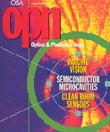
January 1998 Issue
- New Advances in Imaging for Vision Research
- Quantum Well and Quantum Dot Light Emitters Confined in Oxide-Semiconductor Microcavities
- Sensing Rogue Particles with Optical Scattering
- Michelson's Stellar Interferometer
- OSA's Electronic Information Committees
- Catadioptric Magnifier
- Books for Optics Experimenters
- Browse all Issues
Feature Articles
New Advances in Imaging for Vision Research
Traditional eye imaging techniques are being refined and improved with the help of new technologies such as adaptive optics, VCSELs, and MRI. Will they move from the research labs to clinical settings? Reiss chronicle some of the challenges, developments, and results in this article.
by Susan M. ReissQuantum Well and Quantum Dot Light Emitters Confined in Oxide-Semiconductor Microcavities
Smaller sized, low power silicon semiconductor devices can be used to create more powerful computer chips, but also result in greater difficulty in signal transmission. Recent developments in fabricating III–V microcavity lasers and III–V quantum dots offer possible solutions.
by Dennis G. Deppe and Diana L. HuffakerSensing Rogue Particles with Optical Scattering
As semiconductor wafers and other optoelectronic devices grow smaller, the detection of microscopic dust and other particles prior to manufacturing becomes increasingly important. Fabiny looks inside an optical sensor that is cleaning up this industry.
by Larry FabinyMichelson's Stellar Interferometer
The essential idea behind the stellar interferometer is that of a double-slit interferometer, shown in Figure 1. This type of instrument dates back to 1868 when Fizeau1 proposed using it to measure the diameters of the fixed stars. Some modern textbooks2 describe the stellar interferometer in the language of coherence theory, which tends to obscure its fundamental simplicity. This article presents the original concept in its simplest form, while providing an historical perspective.
by Masud MansuripurOSA's Electronic Information Committees
Some of the most exciting changes in the world today result from advances in electronic communications. It doesn't really matter anymore what you do or where you live, new communication technology is almost certainly affecting how you work. For technical professionals the impact is even greater and affects how we learn, how we do research, how we buy, how we publish, and how we communicate with colleagues and our professional societies. A number of years ago, OSA realized how important these changes would become to members and responded by creating committees to advise the Society on the impact of, and the opportunities provided by, new forms of electronic publishing, electronic communication, and digital technology.
by Mike DuncanCatadioptric Magnifier
A single spherical mirror, with an aperture stop placed at its center of curvature, forms an image that suffers only from spherical aberration and field curvature. To correct spherical aberration for all field points, an aspheric plate can be placed at the stop. This combination of a spherical mirror and aspheric corrector plate defines the classic Schmidt camera, invented by Bernard Schmidt in the early 1930s.1 If either the aperture or focal length of a Schmidt camera is sufficiently small, then it is possible to eliminate the aspheric corrector plate and still achieve high quality imagery. This system is commonly known as a lensless Schmidt camera.
by J. Brian CaldwellBooks for Optics Experimenters
In the April 1996 Light Touch column, I gleefully wrote about colorful experiments demonstrating stress birefringence in gelatin. The Nobel prize winner within me secretly hoped that someday I might achieve great fame and fortune for an astonishing discovery made while teaching children—using materials purchased at the local supermarket! Then, as I perused a display at the OSA Annual Meeting a few months later, I was shocked to discover a delightful little book for children by Vicki and Josh Cobb that described polarization experiments with "stressed-out gelatin!"
by Michael E. Knotts

![A multiplexed image of a human tonsil acquired. [NIAID] using the iterative bleaching extends multiplexity (IBEX) method.](https://opnmedia.blob.core.windows.net/$web/opn/media/images/articles/2024/0424/departments/202404-cover-web.jpg?ext=.jpg)
